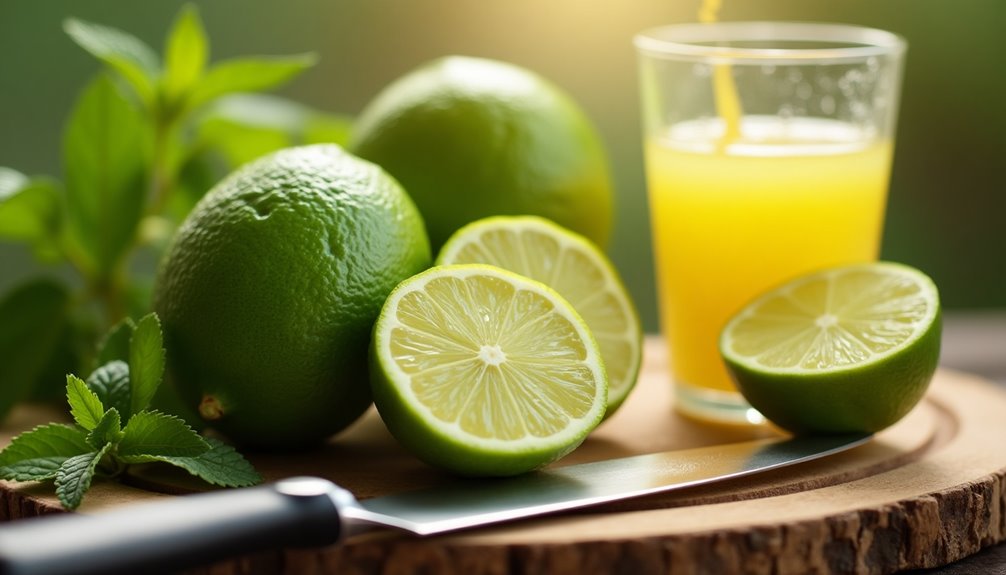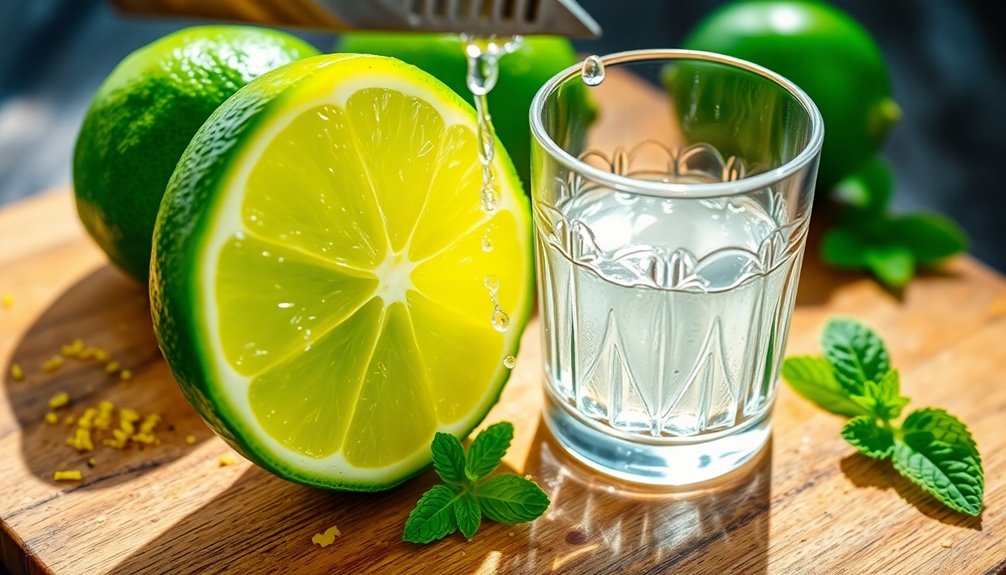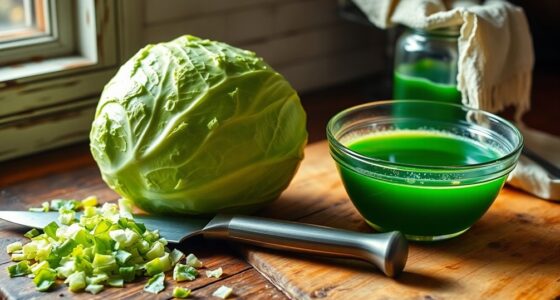To make fresh lime juice, start by selecting ripe, firm limes that feel slightly soft. Roll them on a hard surface to break down membranes, then slice in half and squeeze out the juice. You'll get about 2 tablespoons per lime, so adjust based on how much you need. Strain the juice for a smoother texture if desired. Store any leftovers in the fridge or freeze for later use. You'll discover more tips and tricks along the way!
Key Takeaways
- Select firm, vibrant limes that are slightly soft for optimal juiciness and avoid any with blemishes.
- Roll the limes on a hard surface to break down membranes and enhance juice extraction.
- Slice the limes in half and use a juicer or your hands to squeeze out the juice.
- Strain the juice through a fine-mesh sieve to remove pulp and seeds for a smoother finish.
- Store fresh lime juice in the refrigerator for up to 3 days or freeze in ice cube trays for longer use.

Making fresh lime juice is easier than you might think! With just a few simple steps, you can create a delicious, homemade lime juice that's perfect for refreshing drinks, marinades, or even desserts. The first thing you'll want to do is gather your limes. When picking out fresh limes, look for ones that are firm but slightly soft to the touch. This indicates they're juicy and ripe.
To maximize the amount of juice you can extract, roll the limes on a hard surface using your palm. This technique helps to break down the membranes inside, releasing more juice when you cut and squeeze them. Once you've rolled your limes, slice them in half. You can use a juicer for this part, or if you don't have one, your hands will work just fine. By applying a little pressure, you can easily squeeze out the juice.
On average, each lime yields about 2 tablespoons (1 ounce or 30 ml) of juice. So, if you're planning to make a larger batch, consider using about six limes, which will give you roughly ¾ cup of fresh lime juice.
If you prefer a smoother texture in your lime juice, you can strain it through a fine-mesh sieve to remove any pulp or seeds. This step is optional, but it can make a big difference if you're using the juice for cocktails or other recipes where a clean finish is desired.
Speaking of recipes, fresh lime juice is an essential ingredient in many classic drinks. Think margaritas, mojitos, or even a simple limeade. You can combine your freshly squeezed lime juice with cold water and granulated sugar to create a refreshing drink that's perfect for a hot day.
Once you've made your lime juice, you might wonder how to store it. If you plan to use it within a few days, simply pour it into a clean container and pop it in the refrigerator. It'll stay fresh for up to 3 days. But if you want to keep it longer, consider freezing it. Pour the juice into ice cube trays, freeze until solid, and then transfer the cubes to a freezer bag. This way, you can enjoy the taste of fresh lime juice for up to 3 months. Whenever you need a touch of citrus, just grab a cube or two!
Now that you know how to make fresh lime juice, you can enjoy its bright flavor in various dishes and drinks. Whether you're whipping up a quick limeade or using it in a marinade, the zest of fresh limes can elevate your culinary creations. So go ahead, squeeze those limes, and enjoy the burst of freshness that homemade lime juice brings!
Frequently Asked Questions
How to Get Fresh Lime Juice?
To get fresh lime juice, start by picking ripe limes, like Persian or key limes. They give you the most juice.
Microwave them for 20 seconds to soften, then roll them under your hand and cut them in half. Use a manual juicer or glass juicer to squeeze out the juice, pressing firmly.
If you need more, chop the limes, blend with a bit of water, and strain for concentrated juice.
How to Make Perfect Lime Juice?
You've probably wondered how to make perfect lime juice while sipping your favorite cocktail.
Start by softening your limes in the microwave for 20 seconds; this helps release more juice. Roll them under your hand, then slice in half. Use a juicer to extract every drop, yielding about 2 tablespoons per lime.
For more, blend chopped limes with a bit of water and strain. Store the juice in the fridge or freeze it for later! You can also experiment by adding other fruits like oranges or grapefruits to your lime juice for a refreshing twist. To ensure maximum freshness and flavor, it’s important to know how to store fresh juice properly; invest in airtight containers to avoid oxidation. Remember to label your containers with the date, so you can enjoy your delicious juice at its best!
Is Bottled Lime Juice the Same as Fresh Lime Juice?
No, bottled lime juice isn't the same as fresh lime juice.
When you squeeze fresh limes, you get a vibrant flavor and pure juice without additives. Bottled versions often contain preservatives, dulling the taste and altering the freshness.
While both can be used in recipes, fresh lime juice stands out for its brightness and higher vitamin C content.
If you're aiming for the best flavor, you should definitely opt for fresh.
How Many Limes Make 1 Cup of Lime Juice?
Imagine squeezing a treasure trove of flavor from those little green gems. To fill a cup with lime juice, you'll need about six limes. Each one brings its own zest, producing roughly 2 tablespoons of juice.
When you pick your limes, look for ones that feel heavy and firm—they're your best bet for juiciness. Rolling them under your hand helps, too, so you can maximize that refreshing, tangy goodness!
Conclusion
In the end, you've crafted a refreshing, zesty delight that dances on your taste buds. With just a few simple steps, you've transformed fresh limes into a luscious liquid that brightens any beverage or dish. So, whether you're sipping solo or sharing with friends, your homemade lime juice will surely spark smiles and satisfaction. Embrace the vibrant taste and let your culinary creativity shine with this simple, sensational squeeze! Enjoy every drop of your delicious creation!
Cindy thoroughly researches juicing trends, techniques, and recipes to provide readers with practical advice and inspiration. Her writing style is accessible, engaging, and designed to make complex concepts easy to understand. Cindy’s dedication to promoting the advantages of juicing shines through her work, empowering readers to make positive changes in their lives through the simple act of juicing.

















